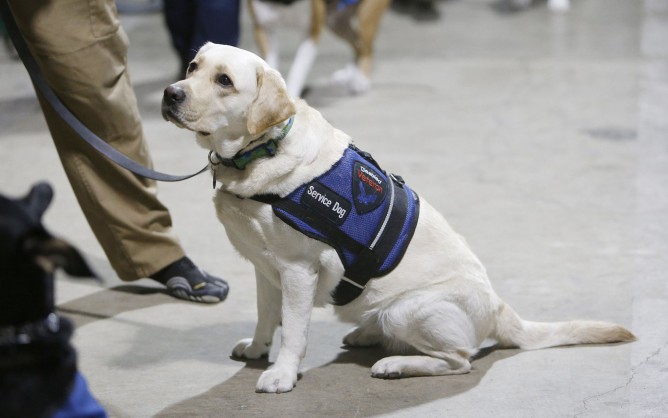A valued client asked a question on service dogs being brought into public buildings:
Question:
I’m getting our attendance list together for Bulli Ray training, and the Tax Collector’s office has posed a question about “service” dogs that seem to be increasing exponentially here. We realize there are limitations about what we can ask of their owners, but do you have any experience or advice on how to handle dogs being brought into public buildings? thanks
Answer:
Behavior is the best indication whether it’s a well-trained team or not. If a “Service Dog” is interrupting a business’ daily operation with its behavior, causing problems in a housing situation, is a danger to anyone or its conduct is NOT conduct acceptable in a Service Dog (barking, growling, stealing food from other clients, knocking people over, jumping, or many other behaviors), by law, the manager or business owner has every right to ask the person to remove the dog from the premises, “Service Dog” or not.

§ 35.136 Service animals
(a) General. Generally, a public entity shall modify its policies, practices, or procedures to permit the use of a service animal by an individual with a disability.
(b) Exceptions. A public entity may ask an individual with a disability to remove a service animal from the premises if—
(1) The animal is out of control and the animal’s handler does not take effective action to control it; or
(2) The animal is not housebroken.
(c) If an animal is properly excluded. If a public entity properly excludes a service animal under
§ 35.136(b), it shall give the individual with a disability the opportunity to participate in the service, program, or activity without having the service animal on the premises.
(d) Animal under handler’s control. A service animal shall be under the control of its handler. A service animal shall have a harness, leash, or other tether, unless either the handler is unable because of a disability to use a harness, leash, or other tether, or the use of a harness, leash, or other tether would interfere with the service animal’s safe, effective performance of work or tasks, in which case the service animal must be otherwise under the handler’s control (e.g., voice control, signals, or other effective means).
(e) Care or supervision. A public entity is not responsible for the care or supervision of a service animal.
(f) Inquiries. A public entity shall not ask about the nature or extent of a person’s disability, but may make two inquiries to determine whether an animal qualifies as a service animal. A public entity may ask if the animal is required because of a disability and what work or task the animal has been trained to perform. A public entity shall not require documentation, such as proof that the animal has been certified, trained, or licensed as a service animal. Generally, a public entity may not make these inquiries about a service animal when it is readily apparent that an animal is trained to do work or perform tasks for an individual with a disability (e.g., the dog is observed guiding an individual who is blind or has low vision, pulling a person’s wheelchair, or providing assistance with stability or balance to an individual with an observable mobility disability).
(g) Access to areas of a public entity. Individuals with disabilities shall be permitted to be accompanied by their service animals in all areas of a public entity’s facilities where members of the public, participants in services, programs or activities, or invitees, as relevant, are allowed to go.
(h) Surcharges. A public entity shall not ask or require an individual with a disability to pay a surcharge, even if people accompanied by pets are required to pay fees, or to comply with other requirements generally not applicable to people without pets. If a public entity normally charges individuals for the damage they cause, an individual with a disability may be charged for damage caused by his or her service animal.
Mitzi Robinson – Bulli Ray Dog Bite Prevention




Leave a Reply
You must be logged in to post a comment.